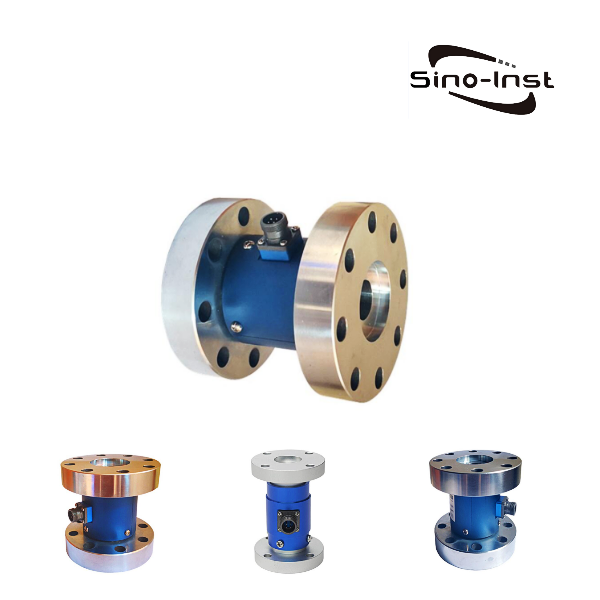
The Reaction Static Torque Sensor is flanged at both ends. It is suitable for static torque test and torque value measurement of discontinuous rotation. During the measurement process, the rotation angle of the sensor body is less than 360 degrees. Continuous rotation is not possible. Suitable for stall testing of rotating power. Widely used in various torque testers, torque wrenches and other static torque measurement fields.
Features of 98 Flange-to-Flange Reaction Static Torque Sensor
- The resistance strain is an integrated product composed of sensitive components and integrated circuits, with high precision and stable performance;
- Measuring range: 0-0.2-50KN.m optional;
- It can measure the torsion force in both positive and negative directions;
- Both ends are flanged links, easy to install;
- Suitable for measurement of static torque;
- Wide measurement range, large, medium and low range can be measured, non-standard can be customized;
Technical Parameters
| Range | 0-0.2,0.5,1,10,20,50,100,500,1000N.m…50KN.m support non-standard customization |
| Output | 1-1.5mV/V optional amplifier 0-±5V, 0-±10V, 4-20mA, 0-20mA, etc. |
| Zero output | ±1%F.S |
| Precision error | ±0.1%F.S±0.2%F.S±0.3%F.S |
| Hysteresis | ≤±0.05%F.S |
| Repeatability | ≤±0.05%F.S |
| Creep | ≤±0.03%F.S/30min |
| Zero temperature drift | 0.03%F.S/10℃ |
| Temperature Sensitivity Drift | 0.03%F.S/10℃ |
| Input resistance | 750±10Ω |
| Output resistance | 700±5Ω |
| Insulation resistance | ≥5000M2/100VDC |
| Excitation voltage | 9-15VDC external amplifier 12/24VDC (9-30VDC) |
| Temperature Compensation Range | -10~60℃ |
| Range of working temperature | -20~80℃ |
| Safe overload | 150%F.S limit 200%F.S |
| Cable Specifications | 5.2mm*3m |
| Shell material | Stainless or Alloy Steel |
Dimensions
| Model | Range(Nm) | A | B | φC | φD | φE | F | G |
| 98A | 0-100 | 85 | 10 | 59 | 22 | 12 | 5 | 4-φ6.5 |
| 98B | 0-1000 | 95 | 20 | 98 | 40 | 20 | 6 | 8-φ10.5 |
| 98C | 0-5000 | 95 | 20 | 125 | 50 | 40 | 6 | 8-φ12.5 |
| 98D | 0-10000 | 160 | 30 | 190 | 80 | 30 | 6 | 8-φ19 |
| 98E | 0-50000 | 220 | 45 | 308 | 130 | 80 | 5 | 12-φ26 |
Learn More About 98 Flange-to-Flange Reaction Static Torque Sensor
If you cannot find an answer to your question in our 98 Flange-to-Flange Reaction Static Torque Sensor, you can always contact us and we will be with you shortly.
More Featured Torque Sensors For Sale
98 Flange-to-Flange Reaction Static Torque Sensor
Sino-Inst is a manufacturer of 98 Flange-to-Flange Reaction Static Torque Sensor. We offer more than 20 types of Reaction Static Torque Sensors. Reaction Static Torque Sensors can measure a variety of different mechanical power, rotational speed and torque measuring devices.
Reaction Static Torque Sensor is also called reaction torque sensor, torque transducer. Mainly used for torque measurement in Static situations. Reaction Static Torque Sensor, with flanges connection at both end; suitable for static torque measurement.
Sino-Inst’s Reaction Static Torque Sensors, made in China, have good quality, with better prices. Our Reaction Static Torque Sensors are widely used in China, India, Pakistan, USA and other countries.
Sino-Inst’s entire team is well trained, so we can ensure that each customer’s needs are met. If you need any help with your product requirements, whether it is a Reaction Static Torque Sensor, level sensors, or other equipment, please give us a call.
Request a Quote
Wu Peng, born in 1980, is a highly respected and accomplished male engineer with extensive experience in the field of automation. With over 20 years of industry experience, Wu has made significant contributions to both academia and engineering projects.
Throughout his career, Wu Peng has participated in numerous national and international engineering projects. Some of his most notable projects include the development of an intelligent control system for oil refineries, the design of a cutting-edge distributed control system for petrochemical plants, and the optimization of control algorithms for natural gas pipelines.
98 Flange-to-Flange Reaction Static Torque Sensor
The Reaction Static Torque Sensor is flanged at both ends. It is suitable for static torque test and torque value measurement of discontinuous rotation. During the measurement process, the rotation angle of the sensor body is less than 360 degrees. Continuous rotation is not possible. Suitable for stall testing of rotating power. Widely used in various torque testers, torque wrenches and other static torque measurement fields.
Product SKU: 98 Flange-to-Flange Reaction Static Torque Sensor
Product Brand: Sino-Inst
Product Currency: USD
Product Price: 170
Price Valid Until: 2029-09-09
Product In-Stock: InStock
5